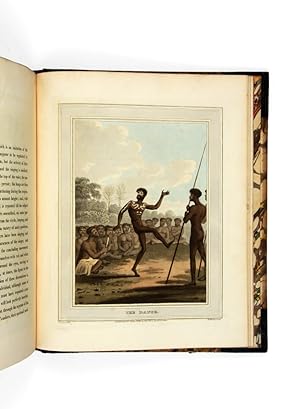A propos de cet article
Quarto, 160 pages letterpress without pagination, 100 handcoloured aquatints, with the 1813 New South Wales supplement bound at rear (this comprising separate title-page, dedication leaf, 10 handcoloured aquatints and 14 letterpress pages); the early issue with watermarks dated 1811 in a handsome contemporary binding of half green russia, spine in compartments with gilt lettering and ornament. One of the outstanding aquatint books of the early nineteenth century, including the remarkable supplementary suite of ten plates depicting life and customs of Australian First Nations people. This is an early issue (with watermarks dated 1811) of the first edition of Foreign Field Sports, a collection of 100 hunting scenes from cultures across the globe, including Africa, Europe, the Middle East and the Americas. This complete edition includes the 'Field Sports, &c. &c. Of the Native Inhabitants of New South Wales' separately published by Edward Orme the previous year. It comprises ten plates of Aboriginal hunting and ceremonial scenes with descriptive letterpress, separate title-page and a dedication leaf to Governor Bligh. The ten scenes are remarkable in the history of early colonial Australian art, offering good-natured and unprejudiced depictions of First Nations life in an era when pejorative representation was the norm. The scenes include smoking out possums, a kangaroo hunt, spearing birds on the wing, fishing from canoes, a native dance, painted warriors, men in single combat and an idyllic night scene. Delicately hand-coloured and expertly printed, the ten plates 'are without question the most attractive and sympathetic of the early British depictions of the native inhabitants' (Wantrup, Australian Rare Books, 2 ed., pp. 367-370). Although the dedication leaf and plates are signed by John Heaviside Clark, he was a commercial artist working in London, turning original sketches into finished drawings ready for the engraving process, and would not have been the artist responsible for the plates and their accompanying text. For decades controversy has surrounded the true identity of the artist of the Aboriginal studies. Wantrup argues convincingly for the natural history illustrator John Lewin, attributing the stylistic differences between Lewin's known work and the plates in this volume to the conventions and discretionary modifications made by Clark and his engraver. He maintains that the artist must have experienced prolonged contact with the Aboriginal peoples of the Sydney region to produce studies of such detail, and through a process of elimination leaves Lewin as the only reasonable candidate. Nonetheless, Richard Neville, in his monograph on Lewin, disagrees with this attribution on the basis of stylistic and aesthetic considerations. Whoever the artist, this was "the first Australian coloured plate book properly so called, it is the first separate account of the Aborigines, and it is a fine book in its own right" (op. cit.). Foreign Field Sports is also testament to the quality of English colour plate book publishing during the early decades of the nineteenth century, an era that saw other magnificent books such as Ackermann's Microcosm of London. Competition between publishers produced unprecedented technical and artistic excellence, especially in the perfection of professional handcolouring techniques (of which Foreign Field Sports is a paradigm example). These volumes were expensive in their own time, often priced at several guineas a volume, and took pride of place in private book collections. . Joints and extremities rubbed, in the original attractive.
N° de réf. du vendeur 4205932
Contacter le vendeur
Signaler cet article




